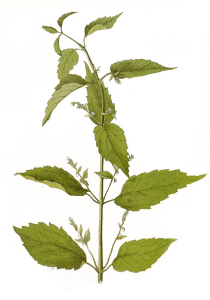
פלבונואידים (baicalein, baicalin, lateriflorin), פנולים (cinnamin acid, caffeic acid), דיטרפנים (neoclerodane, scutelaterins), חומצות אמינו, שמן נדיף (כולל ססקוויטרפנים).
פעילות רפואית
מרגיע, נוגד חרדה, נוגד עווית (שרירים), נוגד פרכוסים, מזין מערכת העצבים.
התוויות
חרדה, לחץ (סטרס), פרקינסון, טרשת נפוצה, הפרעות קשב וריכוז, הפרעות שינה (אינסומניה), אפילפסיה
Mills. S, Bone K, The Essential Guide to Herbal Safety. Churchill Livingstone, 2005. https://www.elsevier.com/books/the-essential-guide-to-herbal-safety/mills/978-0-443-07171-3
McGuffin M, Hobbs C, Upton R, Goldberg A (eds). American Herbal Products Association’s Botanical Safety Handbook. Boca Raton, FL: CRC Press, 1997. http://www.ahpa.org/Resources/BotanicalSafetyHandbook.aspx
Grieve M: A Modern Herbal, New York, 1971, Dover Publications. https://www.bookdepository.com/Modern-Herbal-Maude-Grieve/9780486227986
Duke JA. Handbook of Medicinal Herbs. Boca Raton, FL: CRC Press; 1985. https://www.crcpress.com/Handbook-of-Medicinal-Herbs/Duke/p/book/9780849312847
Huxtable RJ. The myth of beneficent nature: the risks of herbal preparations. Ann Intern Med. 1992 Jul 15;117(2):165-6. https://www.semanticscholar.org/paper/The-myth-of-beneficent-nature%3A-the-risks-of-herbal-Huxtable/0244cf4ae7e6a5059d0df134B79560159b494f40
MacGregor FB, Abernethy VE, Dahabra S, Cobden I, Hayes PC. Hepatotoxicity of herbal remedies. BMJ. 1989 Nov 4;299(6708):1156-7. https://www.ncbi.nlm.nih.gov/pmc/articles/PMC1838039/
Harvey J, Colin-Jones DG. Mistletoe hepatitis. Br Med J (Clin Res Ed). 1981 Jan 17;282(6259):186-7. https://www.ncbi.nlm.nih.gov/pubmed/6779941
De Smet PAGM, Keller K, Hansel R, et al. eds: Adverse effects of Herbal Drugs, Vol. 2, Berlin, 1993, Springer-Verlag. https://www.springer.com/gp/book/9783540558002
Weeks GR, Proper JS. Herbal medicines – Gaps in our knowledge. Aust J Hosp Pharm 1989, 19:155-157. https://www.researchgate.net/publication/288195578
Hullar TE, Sapers BL, Ridker PM, Jenkins RL, Huth TS, Farraye FA. Herbal toxicity and fatal hepatic failure. Am J Med. 1999 Feb;106(2):267-8. https://www.ncbi.nlm.nih.gov/pubmed/10230761
De Berardinis V, Moulis C, Maurice M, Beaune P, Pessayre D, Pompon D, Loeper J. Human microsomal epoxide hydrolase is the target of germander-induced autoantibodies on the surface of human hepatocytes. Mol Pharmacol. 2000 Sep;58(3):542-51. https://www.ncbi.nlm.nih.gov/pubmed/10953047
Castot A, Djezzar S, Deleau N, Guillot B, Efthymiou ML. [Pharmacovigilance off the beaten track: herbal surveillance or pharmacovigilance of medicinal plants]. Therapie. 1997 Mar-Apr;52(2):97-103. https://www.ncbi.nlm.nih.gov/pubmed/9231502
De Smet PAGM, Keller K, Hansel R, et al., eds: Adverse effects of Herbal Drugs, Vol. 3, Berlin, 1997, Springer-Verlag. https://www.springer.com/gp/book/9783540601814
Mattéi A, Rucay P, Samuel D, Feray C, Reynes M, Bismuth H. Liver transplantation for severe acute liver failure after herbal medicine (Teucrium polium) administration. J Hepatol. 1995 May;22(5):597. https://www.journal-of-hepatology.eu/article/0168-8278(95)80458-7/fulltext
Lekehal M, Pessayre D, Lereau JM, Moulis C, Fouraste I, Fau D. Hepatotoxicity of the herbal medicine germander: metabolic activation of its furano diterpenoids by cytochrome P450 3A Depletes cytoskeleton-associated protein thiols and forms plasma membrane blebs in rat hepatocytes. Hepatology. 1996 Jul;24(1):212-8. https://www.ncbi.nlm.nih.gov/pubmed/8707265
Loeper J, Descatoire V, Letteron P, Moulis C, Degott C, Dansette P, Fau D, Pessayre D. Hepatotoxicity of germander in mice. Gastroenterology. 1994 Feb;106(2):464-72. https://www.ncbi.nlm.nih.gov/pubmed/8299912
Philip E. Wolfson, David Ludwig Hoffmann. Standardized extracts of Scutellaria lateriflora. United States Patent, May 16, 2006. Available here.
Scheinost ME. Digoxin toxicity in a 26-year-old woman taking a herbal dietary supplement. J Am Osteopath Assoc. 2001 Aug;101(8):444-6. https://www.ncbi.nlm.nih.gov/pubmed/11526877
Awad R. Arnason JT. Trudeau T. Phytochemical and Biological Analysis of Skullcap (Scutellaria lateriflora L.): A medicinal plant with anxiolytic properties. Phytomedicine 2003,10: 640-649. https://www.ncbi.nlm.nih.gov/pubmed/14692724
Wolfson P. and Hoffmann DL. An investigation into the efficacy of Scutellaria lateriflora in healthy volunteers. Altern. Ther. Health Med. 2003, 9: 74-78. https://www.ncbi.nlm.nih.gov/pubmed/12652886
Brock C, Whitehouse J, Tewfik I, Towell T. American Skullcap (Scutellaria lateriflora): a randomised, double-blind placebo-controlled crossover study of its effects on mood in healthy volunteers. Phytother Res. 2014 May;28(5):692-8. https://www.ncbi.nlm.nih.gov/pubmed/23878109
Felter HW, Lloyd JU. King's American Dispensatory, ed 18, 3rd rev, vol 2, first published 1905, Reprinted Portland, 1983, Eclectic Medical Publications, pp 1739-1741. https://archive.org/details/kingsamericandis02kinguoft/page/1738
לקוחות יקרים, טופס זה מיועד לבקשה לביטול הזמנה בלבד.
לצורך מענה מהיר ומדויק יש למלא את כל השדות.
במקרה של שינוי הזמנה, או כל נושא אחר לשירות לקוחות
יש לפנות בטלפון 04-9014848 שלוחה 2